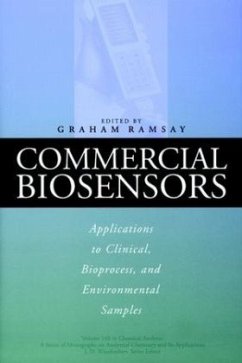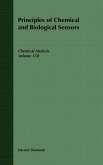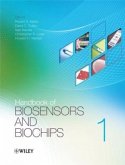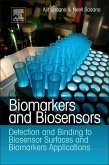Combining design aspects of biotechnology and analytical instrumentation, immunobiosensors are a method of rapid, in-field detection of toxins such as pesticides and hazardous wastes. Easy-to-use and manufacture, inexpensive, reusable, and accurate, immunobiosensors are attracting a great deal of attention from analytical chemists involved with environmental, clinical and food analysis. This book provides the reader with a thorough understanding of immunobiosensors, with an emphasis on their sensitivity, application, accuracy, and analytical protocols.
Commercial Biosensors offers professionals an in-depth look at some of the most significant applications of commercially available biosensor-based instrumentation in the medical, bioprocess, and environmental fields. Featuring contributions by an international team of scientists, the book provides readers with an unparalleled opportunity to see how their colleagues around the world are using these powerful new tools.
Commercial Biosensors is divided into three sections. In the first, which is devoted to applications of biosensors to clinical samples, the authors explore how biosensors are currently being used for in-home diabetes monitoring, point-of-care diagnostics, and noninvasive sensing, and biomedical research. The second section deals with cutting-edge applications of biosensors in bioprocess control- for example, measuring glucose, sucrose, glutamate, or choline concentrations during food and beverage production and measuring ethanol concentration during beer fermentation. In the final section, readers learn about the use of biological oxygen demand (BOD) biosensors for monitoring environmental samples.
This book is an indispensable addition to the reference libraries of biosensor technologists, physicians, analytical chemists, environmental engineers, pesticide chemists, clinical chemists, and food chemists.
An in-depth exploration of state-of-the-art commercial biosensor technology and its aplications.
Commercial biosensor technology has taken off over the past few years, and the number of applications is growing rapidly. This book offers professionals a timely and authoritative look at some of the most important of these applications. Over the course of seven chapters authored by leading international experts, readers learn all about the latest in:
_ Biosensors and diabetes management
_ Microfabricated biosensors and point-of-care diagnostics systems
_ Noninvasive biosensors in clinical analysis
_ Surface plasmon resonance and evanescent wave biosensors
_ Biosensor-based instruments in food and beverage production
_ Biosensors in environmental sampling
Commercial Biosensors is required reading for all professionals who would like to take advantage of the enormous potential of one of today's most important new commercial technologies.
Commercial Biosensors offers professionals an in-depth look at some of the most significant applications of commercially available biosensor-based instrumentation in the medical, bioprocess, and environmental fields. Featuring contributions by an international team of scientists, the book provides readers with an unparalleled opportunity to see how their colleagues around the world are using these powerful new tools.
Commercial Biosensors is divided into three sections. In the first, which is devoted to applications of biosensors to clinical samples, the authors explore how biosensors are currently being used for in-home diabetes monitoring, point-of-care diagnostics, and noninvasive sensing, and biomedical research. The second section deals with cutting-edge applications of biosensors in bioprocess control- for example, measuring glucose, sucrose, glutamate, or choline concentrations during food and beverage production and measuring ethanol concentration during beer fermentation. In the final section, readers learn about the use of biological oxygen demand (BOD) biosensors for monitoring environmental samples.
This book is an indispensable addition to the reference libraries of biosensor technologists, physicians, analytical chemists, environmental engineers, pesticide chemists, clinical chemists, and food chemists.
An in-depth exploration of state-of-the-art commercial biosensor technology and its aplications.
Commercial biosensor technology has taken off over the past few years, and the number of applications is growing rapidly. This book offers professionals a timely and authoritative look at some of the most important of these applications. Over the course of seven chapters authored by leading international experts, readers learn all about the latest in:
_ Biosensors and diabetes management
_ Microfabricated biosensors and point-of-care diagnostics systems
_ Noninvasive biosensors in clinical analysis
_ Surface plasmon resonance and evanescent wave biosensors
_ Biosensor-based instruments in food and beverage production
_ Biosensors in environmental sampling
Commercial Biosensors is required reading for all professionals who would like to take advantage of the enormous potential of one of today's most important new commercial technologies.








